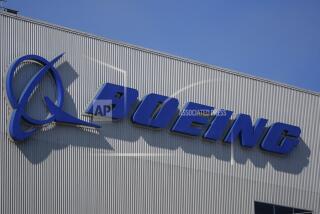New Layoffs Loom at McDonnell O.C. Division : Jobs: Space systems plant workers dealt blow by Pentagon decision favoring Seattle’s Boeing.
HUNTINGTON BEACH — Workers at McDonnell Douglas Corp.’s space systems plant, along with hundreds of others in the Southern California aerospace industry, face more layoffs following NASA’s decision Tuesday to make Boeing Corp. the prime contractor for the often-criticized Space Station Freedom.
McDonnell’s space systems division in Huntington Beach, which has been working on the multinational Freedom project for nearly six years, was given a more limited role as one of Boeing’s subcontractors.
Though it has laid off thousands of workers at its Long Beach aircraft plant and other manufacturing sites, McDonnell said it was not all that discouraged by losing the National Aeronautics and Space Administration contract. It said it hopes that Congress will support the space station and that Boeing will cut it in for a big chunk of the work.
“We expect some downsizing,” said Sheila Carter, a company spokeswoman. “Obviously, we don’t know what it will be until we negotiate with NASA and Boeing. Also, we don’t know where the layoffs would come from, here or Houston.”
The division employs 1,500 people at its Orange County plant and 1,000 more in Houston.
The scope of McDonnell’s role, which has included creating the basic structure of the space station, will take shape in the next few weeks, Carter said.
The mood among employees was one of anxiety and uncertainty. The company announced through an in-house public address system at 10 a.m. and 4 p.m. that it had lost out as prime contractor. Some employees said they were numb.
“It’s the uncertainty more than anything. We’ve been through a lot of transition in this program,” said John Lauger of Santa Ana, an engineer with the space systems division for seven years.
The company won a $4.3-billion contract in December, 1987, to design and build components of the space station. Since then it also has incorporated NASA-mandated changes, which were aimed at cutting costs. Now the space agency and Boeing will reconfigure the station once more.
The redesign is “more a factor for the employment situation than Boeing being the main contractor,” said William Risconsin, a space systems engineer for eight years.
“We’re all in limbo basically until we see what the redesign is going to be,” said Rebecca Jones of Huntington Beach, a two-year employee.
Some workers worried about the long-term prospects for the aerospace industry locally.
“This is going to be a problem for Southern California aerospace,” said Kris Kumar, an engineer at the space systems division for 15 years. “Jobs are disappearing. This is going to have an economic impact, but that’s life. What can you do?”
NASA’s decision left McDonnell Douglas and Seal Beach-based Rockwell International Corp. as also-rans in the high-stakes bid to become the prime contractor for the space station. The station has been in development since 1984 and is expected to be operational by 2000.
However, NASA picked both companies, along with Grumman Aerospace Corp., as subcontractors to Boeing in an effort to streamline management of the project. The three companies were part of a group that has spent a total of $11.2 billion working on separate aspects for the space station.
McDonnell Douglas is perhaps in a better position than the other subcontractors to keep a sizable portion of the ultimate project. Much of McDonnell’s work has involved early design and construction and it is further along than other companies, said Tom Williams, another company spokesman.
Under its current contract, McDonnell is responsible for designing and building three parts of the space station--the main truss or backbone for the station, individual pressurized work stations and the infrastructure that connects modules, work stations, solar panels and other objects to the truss.
Much of McDonnell’s work, Williams said, will depend on the amount of money Congress agrees to put into the program, the decision on how much existing work to incorporate into the new design and on how much work would go to the Russians and other countries also working on the project.
“We’ve been a significant player in the space station project since 1987, and we’re going to continue being a significant player,” he said.
More to Read
Inside the business of entertainment
The Wide Shot brings you news, analysis and insights on everything from streaming wars to production — and what it all means for the future.
You may occasionally receive promotional content from the Los Angeles Times.










